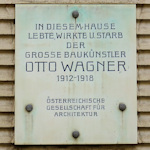
As a son of the city, an architect, a professor, a proponent of Viennese modernism, and an urban planner, Otto Wagner (1841 – 1918) had a major impact both literally and figuratively on the landscape of Vienna.
- See also:
Wagner certainly helped drag Viennese architecture and design away from historical styles and into Jugendstil and beyond, combining aesthetics with usefulness in his many building projects. As he said himself:
Something impractical cannot be beautiful
Below you’ll find details of the main sites relevant to Wagner’s life and work, with notes, addresses, links and/or photos (including houses, stations, bridges, and other important structures he built and/or designed), plus a map at the end.
I can’t promise that every one of the buildings is in its original condition, but they certainly all look like it to my (admittedly untrained and uninformed) eye.
Wagner: his life
First, a few locations related to Wagner’s own life. We begin with the homes…
Otto Wagner Villa
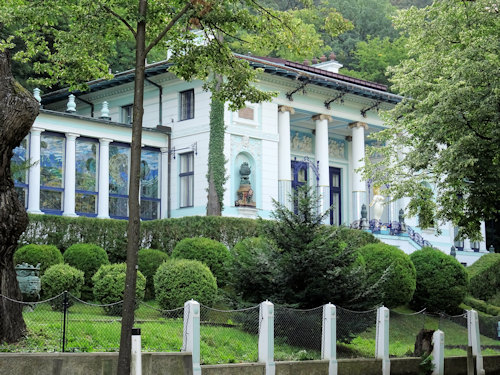
(The interior looks very different now)
Wagner built his palladian residence at Hüttelbergstraße 26 in the late 1880s. It’s now home to the Ernst Fuchs Museum; the same-named artist bought up the dilapidated property and renovated it in his own inimitable style.
Much of the building is new, but the Adolf Böhm-Saal, for example, remains much as it would have been in Wagner’s time there.
Otto Wagner Villa II

(Version 2 took a more modest approach)
The first villa’s successor, built in 1912, is next door at Hüttelbergstraße 28.
Wagner intended the house as a home for his second wife, Louise Stiffel, after his death, but she passed away before him in 1915.
As you can see from the photos, the difference in design between the first and second villas seems almost like a statement of Wagner’s own architectural journey (I’m pretending to know what I’m talking about here).
Döblergasse 4
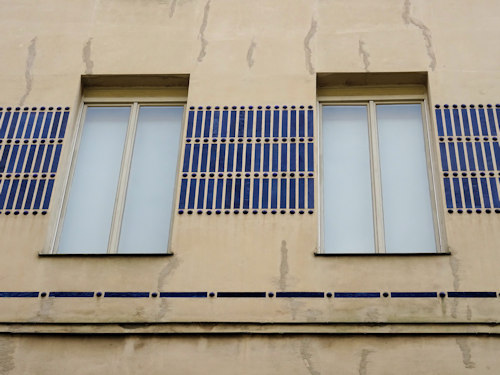
(Döblergasse facade)
Wagner died of erysipelas (a bacterial infection) in this house, which he also designed, on April 11, 1918 (the same year that Klimt and Schiele passed away).
The Österreichische Gesellschaft für Architektur (Austrian Society of Architecture) put up a commemorative plaque on the wall outside. The text says (my rough translation):
The great architect Otto Wagner lived, worked and died in this house 1912-1918
Wagner’s grave

(Other Wagner family members share the grave)
You’ll find Otto Wagner’s grave at the Hietzinger cemetery at Maxingstraße 15 (look for Number 131 in Group 13).
Wagner lies in a family plot just a few yards from Gustav Klimt’s last resting place.
Wagner: museums & landmarks
Wagner’s design work on fittings and furniture gets coverage in several museums that deal with turn-of-the century art and design. For example:
- The Austrian Museum of Applied Arts / Contemporary Art (the MAK) has a Vienna 1900 section where I’ve seen, for example, a 1902 stool designed by Wagner.
- The Leopold Museum has a permanent exhibition which includes Wagner-designed items.
- The Möbelmuseum Wien (Vienna Furniture Museum) also features several chairs, stools and desks from Wagner’s own apartments and the Postsparkasse building.
WAGNER:WERK museum
This small museum inside the Postsparkasse (see below) designed by Wagner tells the story of the institution and, most importantly, the building.
Learn about the architectural competition that led to the selection of Wagner’s design and discover the importance of the development for ushering in a new era of modern architecture.
Otto Wagner monument

(“This’ll do,” said someone)
An inscribed stone column designed by Josef Hoffmann and first erected in 1930 on Heldenplatz. Eventually moved to a side street running alongside the Academy of Fine Arts Vienna in 1959.
The location feels understandable (Wagner taught at the academy) but a little too hidden away.
Otto Wagner-Platz

(Also home to a new Holocaust memorial)
A fairly unobtrusive square, though one rather important building does line the north side: the Austrian National Bank.
The adjoining park has the huge Shoah Memorial to those Jewish people from Austria murdered by the Nazis.
“Otto Wagner Hospital”
Wagner was the leading planner behind the original facilities on this site at Baumgartner Höhe 1 (a centre for psychiatric care and treatment), built 1904 to 1907.
The hospital carrying his name once formed part of a wider group of medical institutions located here that now go under the name Klinik Penzing.
This is also where you’ll find the famous Kirche am Steinhof church (see below). The hospital also features in the TV series, Vienna Blood.
Wagner: his architecture
This is a list of selected Wagner-designed buildings (I believe), with occasional commentary…
Postsparkasse

(The iconic Postal Savings Bank building)
The huge building at Georg-Coch-Platz 2 counts as one of the most famous examples of the Viennese modernist movement, with its marble and metal facade.
Wagner also designed the furniture and fittings inside the Postsparkasse to ensure a common design approach.
Kirche am Steinhof

(View of the church from below; press photo by Lisa Rastl © Wien Museum)
A 1907 Jugendstil masterpiece located at the top of the grounds of the medical institution at Baumgartner Höhe 1. The Wien Museum now manages access to the interior of Kirche am Steinhof.
The building’s golden dome quite took my breath away when I first saw it peeking between the trees. Also known as the Leopoldskirche or Otto Wagner church.
Reach the church via the hospital entrance (turn left and follow the signs up the – quite steep – hill) or from above via the large Steinhofgründe park.
Linke Wienziele 40

(The Majolikahaus)
Better known as the Majolika House with its stunning polychrome tiled façade.
Linke Wienzeile 38 is also a beauty (with ornamentation by Kolomon Moser). And the house at Köstlergasse 3 completes the Wagner triumvirate at this location.
Be sure to visit the Naschmarkt opposite: Vienna’s best food market and a gastronomic delight.
Other notable buildings

(The Lupuspavillon)
- St Johannes Nepomuk Chapel at Währinger Gürtel / Klammergasse (built in 1897).
- Lupuspavillon (1913): A standalone hospital building initially intended for Lupus patients. Still a working part of the Klinik Ottakring state hospital last time I checked (Pavilion 24 specialising in, for example, endocrinology, rheumatism and acute geriatric conditions).
If you’re uncomfortable tramping through the hospital to find it, you can see it from the rear via Steinlegasse. There’s not a lot to see, mind.
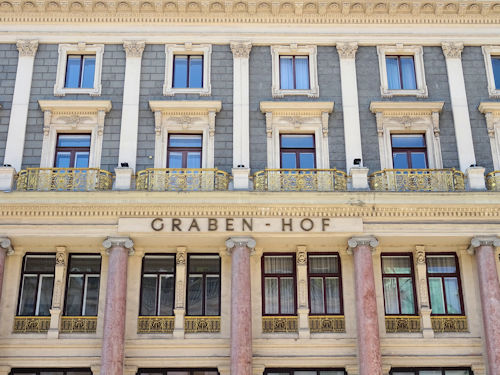
(The Grabenhof)
- Graben 14-15 in the pedestrianised centre of town: Wagner and fellow architect, Otto Thienemann, designed the 1876 building known as the Grabenhof.
- Graben 10 / Spiegelgasse 2: the 1895 Ankerhaus where the artist Hundertwasser once had a studio.
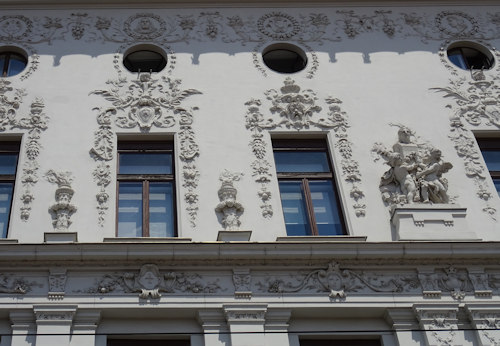
(Rennweg 3, the Croatian Embassy)
- Rennweg 3: the 1890 Hoyos Palace and currently home to the Croatian embassy.
- Garnisongasse 1 / Universitätsstraße 12: apparently known as the “Hosenträgerhaus” (“braces” house) because of the decorative patterns on the south-facing façade of this 1888 building.

(The building on Garnisongasse)
- Other addresses I’ve seen mentioned include Schottenring 23 (1877), Rathausstraße 3 (1881), Stadiongasse 6-8 (1883 and currently the Columbian embassy), Hohenstaufengasse 3 (1884), Lobkowitzplatz 1 (1884), Rennweg 5 / Auenbruggergasse 2 (1891) and Neustiftgasse 40 (1910)
Transport infrastructure
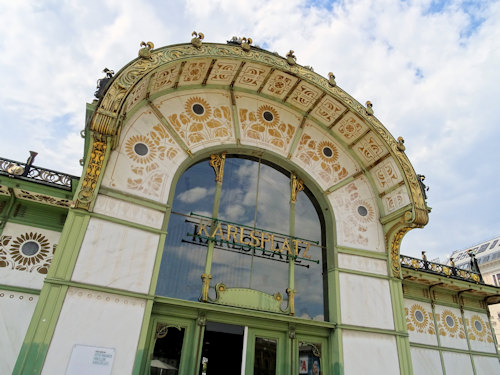
(Karlsplatz pavilion)
Wagner took the position of chief artistic director for the Stadtbahn, a collection of urban railway lines planned and constructed at the turn of the 19th and 20th centuries.
The project, intended to serve a growing and flourishing city, eventually foundered on multiple rocks…notably WWI, the subsequent break up of Austria-Hungary, and the economic problems that followed.
The Stadtbahn routes find their modern expression within what are now the U6 subway line, the U4 subway line, and the S45 city train line.
Wagner designed the new Jugendstil station buildings, bridges, etc. along the Stadtbahn. You can still see many in more or less their original condition.
S45 stations
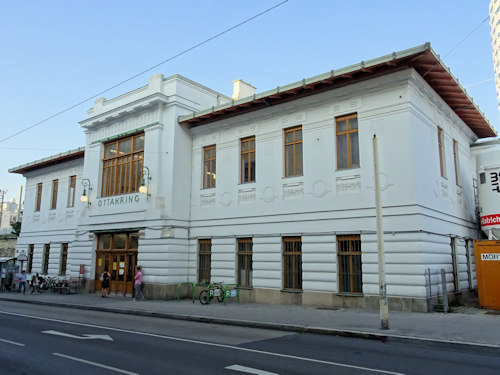
(Ottakring station)
The “Vorortelinie” connected the Hütteldorf railway station in the west and the new Heiligenstadt railway station in the north (it still does, though the trains are a little different now).
Some of the stations already existed before the Stadtbahn, others fell into such disrepair after WWI that new buildings replaced them, and two were added post-Wagner.
These three stations, however, were successfully restored to more or less their original Otto Wagner-designed glory:
- Ottakring
- Hernals (my local station!)
- Gersthof
U4 stations
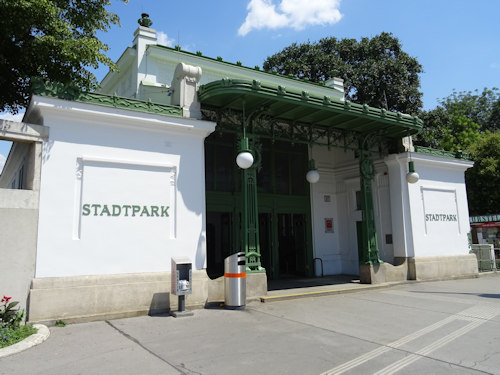
(Stadtpark station)
Aerial bombardment in WWII destroyed some of the Wagner legacy among the stations along today’s U4 subway route. Inconsiderate city planners did a similar job in later years.
Nevertheless, many of the entrance buildings retain their original Wagner design, including (I think) those at Margaretengürtel, Pilgramgasse, Kettenbrückengasse, Roßauer Lände, Friedensbrücke, and Schönbrunn.
The following locations, in particular, serve as stand-out examples of his rail architecture, glowing in white, green, and gold:
- Stadtpark at the edge of the same-named city park in the centre of town (see photo above)
- The Otto Wagner Pavilion at Karlsplatz: a thing of beauty and home to a permanent Otto Wagner exhibition (see photo at the top of this section)
- The Otto Wagner Hofpavillon at Hietzing: built just for Emperor Franz Joseph and friends, with easy access to the Habsburg palace at Schönbrunn
U6 stations

(Gumpendorfer Straße station)
Bombs and planners were a little kinder to the historic stations on the U6. You’ll still find many examples of well-kept Otto Wagner buildings and facilities at:
- Gumpendorfer Straße
- Burggasse-Stadthalle
- Josefstädter Straße
- Alser Straße
- Währinger Straße / Volksoper
- Nußdorfer Straße
Incidentally, the coal-driven trains that travelled along the original Stadtbahn have long entered retirement. But the Remise transport museum has the last surviving original Stadtbahn carriage on permanent display.
Bridges and water facilities
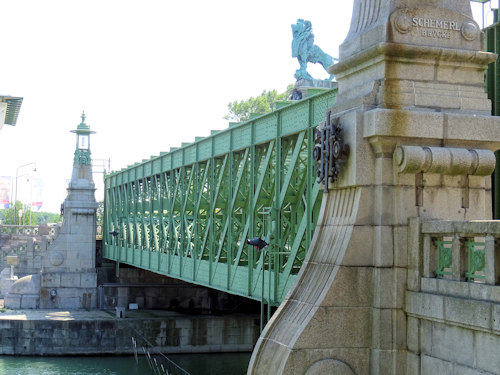
(The Schemerlbrücke)
And so we reach the end of our architectural location guide with three particular locations. I’ve done my best to collate all the existing examples of Otto Wagner’s grandiose works in Vienna, but if you find more, do let me know!
- Stadtbahn viaduct: an 1898 (?) major railway bridge along the Stadtbahn (U6) route. Ride the U6 to Gumpendorferstraße station and then walk south for a couple of minutes. It’s long and obvious.
- Schemerlbrücke: an 1898 bridge and weir system where the Donaukanal channel splits off from the Danube as the latter enters Vienna.
(A little out the way, but you can take the D tram to Nussdorf. Go through the tunnel under the railway station, and a short walk along the riverbank brings you to the Schemerlbrücke.)
- The Otto Wagner Schützenhaus: a water regulation facility from the early 1900s that never made it into operation. Now a riverside restaurant alongside the Donaukanal and erstwhile Before Sunrise movie location.